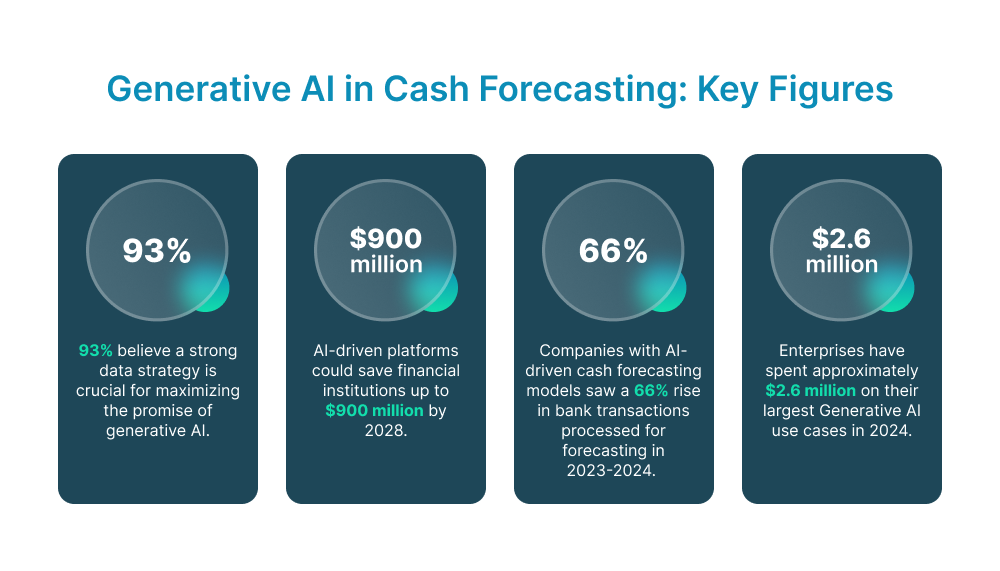Cash Reconciliation
Generative AI in Cash Forecasting: From Data Analysis to Real-Time Decision Support
Learn how generative AI is transforming cash forecasting by enhancing data analysis and providing real-time decision support for better financial management.

Amrit Mohanty
Oct 29, 2024 (Last Updated: Nov 10, 2025)

Businesses looking to minimize risk and maintain optimal liquidity have long found that cash forecasting is an essential function. The conventional approach entailed examining past data, spotting patterns, and formulating informed forecasts on future cash flows. But because of the quick development of generative AI, which analyzes large datasets and offers real-time decision support, this process is being completely transformed. In terms of cash forecasting, generative AI is revolutionary since it provides increased precision, speed, and flexibility. AI is being adopted more quickly worldwide, especially in the financial services industry. For instance, the AI market in the UAE alone was projected to grow from $3.47 billion in 2023 to $5.22 billion in 2024, highlighting its expanding role in optimizing cash forecasting.
Understanding Cash Forecasting: A Complex Process
Cash forecasting is a critical component of financial planning that enables organizations to predict their future cash positions. It is critical for sustaining liquidity, ensuring that businesses can satisfy their obligations while maximizing working capital. Forecasting accuracy is critical; overestimating can result in unneeded borrowing, while underestimating might result in a liquidity deficiency, missing opportunities or, worse, a financial crisis.
Conventional cash forecasting techniques can often be problematic. Spreadsheets, intricate models, and historical data are frequently used by financial teams. These techniques take a lot of time and are prone to human errors. Furthermore, they are less effective in a dynamic corporate environment because they are unable to adjust to unanticipated events such abrupt changes in the market, interruptions in the supply chain, or economic shocks.
Enter Generative AI: A Paradigm Shift
Generative AI offers a new approach to cash forecasting, using advanced machine learning algorithms to analyze vast amounts of historical and real-time data. Unlike traditional AI models that rely on predefined rules and assumptions, generative AI systems can create new data outputs based on the patterns they observe, leading to more accurate and dynamic predictions.
At its core, generative AI in cash forecasting excels in several areas:
1. Data Ingestion and Analysis: Generative AI can process enormous volumes of structured and unstructured data from multiple sources, such as bank statements, invoices, sales data, and market trends. This capability allows for a more holistic view of a company’s financial landscape, factoring in variables that may have been overlooked in traditional methods.
2. Pattern Recognition and Anomaly Detection: Machine learning models can detect patterns in the data that humans may not readily perceive. This enables the AI to not only forecast future cash flows but also identify anomalies or outliers that could signal potential risks, such as delayed payments or unexpected expenses.
3. Real-Time Forecasting: Unlike traditional models, which may require significant time to process and update forecasts, generative AI can provide real-time insights. As new data becomes available, the AI system updates its predictions instantly, offering companies a real-time view of their cash positions and enabling them to respond more quickly to changes.
4. Scenario Analysis and What-If Modeling: Generative AI is particularly powerful when it comes to scenario planning. It can simulate different economic scenarios, helping companies understand how various factors, such as changes in interest rates, market conditions, or supply chain disruptions, might impact their cash flow. This allows businesses to prepare for multiple outcomes and make more informed decisions.
5. Reducing Human Bias: Human forecasters, even experienced ones, may introduce biases based on past experiences or assumptions. Generative AI models, on the other hand, operate purely on data, significantly reducing the risk of bias and making the forecasting process more objective and reliable.

Real-Time Decision Support: The Power of AI in Action
The real potential of generative AI in cash forecasting lies in its ability to provide real-time decision support. As businesses evolve, cash positions can fluctuate rapidly due to factors such as sales cycles, seasonal demand, or changes in the macroeconomic environment. Generative AI systems can continuously monitor these fluctuations, providing financial teams with up-to-date recommendations on how to manage liquidity more effectively.
For instance, if a company faces a sudden increase in accounts receivable due to delayed customer payments, a system such as a generative AI system can immediately flag this issue and recommend specific actions, such as adjusting short-term borrowing plans or renegotiating payment terms. This level of proactive decision-making allows businesses to stay ahead of cash flow challenges and optimize their financial strategies in real time.
Moreover, by incorporating generative AI into existing cash management systems, firms may automate many routine forecasting processes, allowing financial teams to focus on more strategic decision-making. AI-powered systems can handle everything from data gathering and purification to the creation of sophisticated forecasting models, saving time and effort in maintaining accurate forecasts.
Overcoming Challenges in AI Adoption
While the benefits of generative AI in cash forecasting are clear, there are also several challenges that companies must address to fully realize its potential.
- Data Quality: A recent survey indicates that 93% of professionals consider a robust data strategy essential for maximizing generative AI's potential, yet 57% have not updated their data management practices. This underscores the need for organizations to improve data quality, as AI models depend heavily on the quality of their training data. To achieve accurate forecasts, companies must ensure their financial data is clean, complete, and current, potentially requiring substantial investments in data management systems.
- Integration with Legacy Systems: Many businesses still use outdated financial systems incompatible with AI, making integration complex and time-consuming. Coordinating between IT and financial teams is essential for a smooth transition. However, replacing legacy systems with AI-driven platforms could save financial institutions up to $900 million globally by 2028 in operational and compliance costs, highlighting the need to modernize financial infrastructure.
- Skills Gap: Companies using AI-driven cash forecasting models saw a 66% rise in bank transactions processed for forecasting in 2023-2024. However, implementing these systems requires expertise in data science, machine learning, and finance, prompting organizations to invest in training or hiring talent to build and maintain the models. This ensures data accuracy and model evolution for reliable forecasts.
- Cost: On average, enterprises have spent approximately $2.6 million on their largest Generative AI use cases in 2024, with plans to increase this spending by 50% by 2025. Although generative AI systems can deliver significant ROI in the long run, the initial investment in AI technology and infrastructure can be substantial. Smaller companies, in particular, may struggle to justify these costs without a clear understanding of the potential benefits, as they navigate the challenges of adoption amid high upfront expenses.
The Future of Cash Forecasting: A Symbiosis of Human and Machine
Notwithstanding the challenges, there is no doubt that cash forecasting is moving toward a symbiotic relationship between human knowledge and AI-driven insights. Generative AI is designed to supplement human forecasters rather than replace them; by automating repetitive tasks, identifying hidden trends, and providing real-time decision support, AI allows financial teams to focus on value-added operations and strategic planning. As generative AI continues to evolve, we can anticipate even more sophisticated applications in cash forecasting, such as predictive analytics that incorporate non-financial data—like social media sentiment or geopolitical events—and AI models capable of autonomously managing liquidity through algorithmic trading and automated financial decisions.
In summary, generative AI is transforming cash forecasting from a manual, error-prone process into a dynamic, real-time decision-making tool. By leveraging the power of machine learning and data analysis, companies can gain unprecedented visibility into their cash flow, enabling them to make more informed decisions and maintain financial stability in an increasingly unpredictable world. As businesses continue to embrace AI, those that successfully integrate these technologies into their cash forecasting processes will have a significant competitive edge in the marketplace.

